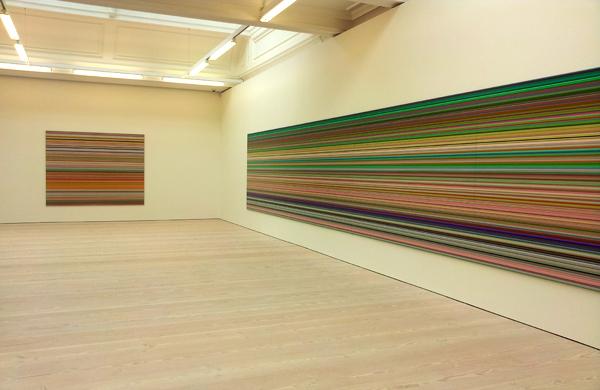The Marian Goodman Gallery presents its inaugural exhibition of German artist Gerhard Richter at the heavily anticipated opening of the gallery. Richter is one of the most critically and commercially successful artists; the octogenarian has been shown by Marian Goodman for some 30 years; but with the opening of Marian Goodman, London – this is the first time the gallery has presented Richter in the city – where the artist presents his new brand of conceptual alchemy.
The exhibition showcases Richter’s recent experiments with abstraction. The show is spread over two floors of what was once a Victorian-era warehouse; having been refurbished by David Adjaye Associates for Marian Goodman’s London opening. The gallery presents three bodies of work by the artist: “Strip,” “Flow,” – and a series of painted photographs, which Richter initiated in 1986.
The show begins with grey monochromes painted on glass, and a monumental assemblage of glass panels, ‘7 Scheiben (Kartenhaus) 932-2’ (2013), which rises from the floor comprised of individual panes of glass at varying angles reflecting disparate images of the gallery space back at the viewer; dissecting its logic into a series of disconnections, by refracting fragmentations. This is a rare example of Richter’s installational work, and suggests the physical quality of the paintings as they reflect the viewer.
But this exhibition is more about colour than it is reflectivity – as brilliance is unleashed in the other rooms of the exhibit. The Richter’s ‘Flow’ series captures paint as if frozen in time. The artist creates the works by pouring various hues of enamel paint into a tray and freezing the transient and kinetic composition by trapping it beneath a glass panel. Sealed in time as instant abstracts; and prevented from flowing into other arbitrary abstracts.
The works ripple beneath more subtle reflections than those of the artist’s monochromes. The layering effect brings a topographical chronology to the making of the paintings. Trapped beneath glass rendering the paint less accessible than traditional works, almost theoretical in nature; highlighting the artist’s experimental stance toward the his practice. This is permanently contemporaneous paint; Richter brings a temporal nature to his latest works.
The artist incorporates these recent experiments within the history of his practice with great skill. The first floor of this exhibition is displaying the artist’s oeuvre ‘Strips’. The balance between the artist’s decision making and chance in the body of work ‘Flow’ also governs Richter’s ‘Strips’ series also. The colours literally reverberate in the space; each work having a different effect to the last, causing an almost illusory, hallucinatory effect on the eye of the viewer; the strips of paint float forward of the surface of the works. The artist’s colours oscillate; the result is simply mesmerising.
The conceptual relevance of this experimental series is clarified by the source of its inception; the entire series is based on just one of Richter’s abstract oil on canvas works dating from 1990. To create this series the painting was digitally photographed and split into thin stripes of colour, the stripes were stretched horizontally to different lengths depending on the size of each new work, printed, and mounted between Alu Dibond and Perspex.
Therefore each of the resulting lines is actually the abstracted memory of the artist’s original singular work of art – the temporal reproduction of a series of abstract brushstrokes. Making Richter’s current output a reflection of the artist’s source material; his own output. The artist also blurs mediums; fusing photography with painting and past works with this contemporary oeuvre. Richter’s current experimental practice is exemplary of the artist’s particular idioms.
The works are digitally printed on paper, trapped under Perspex; the exhibition is a combination of technologically produced ‘secondary’ colours sourced from a ‘primary’ work of art by the same artist; Richter ‘reproduces’ himself and obfuscates the notion of originality, and the distinctions between the artistic choice and the arbitrary decision; all the art in this exhibition is reflexive in nature, and in some way highlights the temporal and subjective nature of an artists ‘evolution’.
Gerhard Richter – Marian Goodman Gallery, London – until 20 December 2014
Words: Paul Black © Artlyst 2014 Photo courtesy of Artlyst all rights reserved

